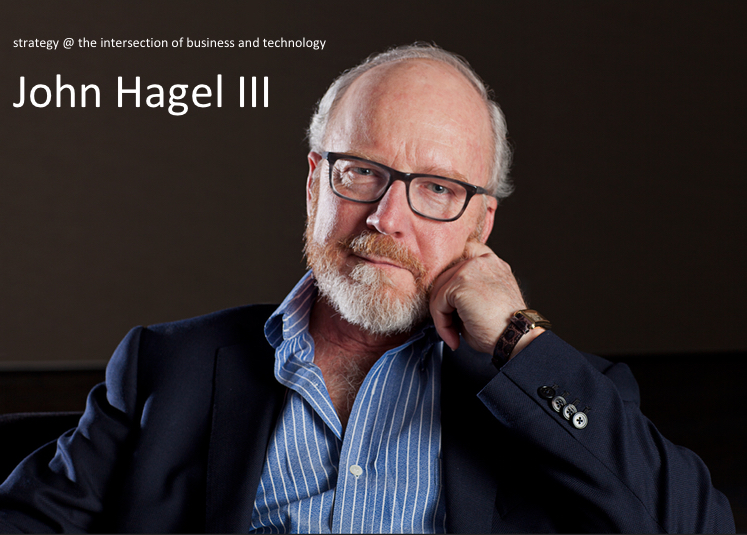
![]()
Speaking
I speak on
topics related to business, strategy and technology. From conceiving and implementing
FAST strategies to pragmatic technology approaches, I seek to challenge traditional
assumptions and help uncover simple, yet profitable solutions best suited to
your company's situation. Get details >>
Papers
- Moving
from Push to Pull - Emerging Models for Mobilizing Resources
(PDF)
John Hagel and John Seely Brown
- Capturing
the Real Value from Offshoring in Asia (PDF)
John Hagel
- The
Agile Dance of Architectures – Reframing IT Enabled Business Opportunities
(PDF)
John Hagel and John Seely Brown
- Overview
of Working Paper Series (PDF)
John Hagel and John Seely Brown
- Break
On Through to the Other Side: A Missing Link in Redefining the Enterprise
(PDF)
John Hagel and John Seely Brown
- The
Secret to Creating Value from Web Services Today: Start Simply (PDF)
John Hagel, John Seely Brown and Dennis Layton-Rodin
- Service
Grids: The Missing Link in Web Services (PDF)
John Hagel and John Seely Brown
- Some
Security Considerations for Service Grids (PDF)
Martin Milani and John Seely Brown
- Control
versus Trust: Mastering a Different Management Approach (PDF)
John Hagel and John Seely Brown
- Orchestrating
Business Processes - Harnessing the Value of Web Services Technology (PDF)
John Hagel and John Seely Brown
- Orchestrating
Loosely Coupled Business Processes: The Secret to Successful Collaboration
(PDF)
John Hagel, John Seely Brown and Scott Durchslag
Viewpoint
August 20, 2002
Restructuring
the Enterprise
Few managers today want to hear anything about restructuring the enterprise. All eyes are focused on quarterly results and relentlessly removing operating cost wherever possible to shore up the bottom line. Do it faster and cheaper, but forget about doing it differently. Restructuring represents a diversion, a remnant of the "change the world" excesses of the 90's.
Despite all efforts to stabilize the ship, companies are continuing to restructure in fundamental ways. Business process outsourcing represents one of the few growth sectors in the midst of general economic slowdown. Business process outsourcing is an extension of the more familiar IT and application outsourcing. Rather than outsourcing just the IT platforms and applications, companies are outsourcing entire business processes in the form of contract manufacturing, third and fourth party logistics operations, call center operations, human resource management, etc. A recent article in CFO Magazine entitled "Everything Must Go: Business Process Outsourcing" highlights the growing interest in this practice. See also the article in InformationWeek "Business Process Outsourcing Grows."
We are also beginning to hear a lot about "front-end/back-end" structures. Julian Birkinshaw, a professor at the London School of Business, wrote an interesting piece on this trend for the August 7, 2002 issue of the Financial Times called "How Long Division Can Add Up to Bigger Numbers". Citing examples from IBM, Hewlett Packard and ABB, he points to the growing trend to structurally separate customer-facing business activities (e.g., sales, marketing and customer service) from supply side business activities (e.g., product development, manufacturing and logistics).
Birkinshaw asserts that these structural changes represent a promising response to growing competitive pressures and the deepening complexity of coordinating activities within the firm. At the same time, he suggests that these new structures are creating problems of their own - friction between the two groups of business operations and the complexity of operating these groups on a multinational scale.
The movement to "shared services" organizations represents a third form of structural change. In a prominent example of this, Procter & Gamble announced the formation of a Global Business Services organization in 1999 as part of a broader structural change initiative. Global Business Services sought to concentrate, standardize and rationalize common support services like accounting, human resource systems, order management and information technology. The GBS unit delivers these services across seven Global Business Units organized by product group. More recently, P & G announced its intention to outsource a substantial portion of the activities and people currently within Global Business Services.
There is clearly a broader pattern here, but it may be only a hint of what is to come. These structural initiatives - business process outsourcing, "front-end/back-end" structures and creation of shared services organizations - may be only partial solutions to the challenges faced by management. As such, they may be merely transitional states, highly unstable and requiring even further restructuring to resolve the growing friction and stress arising in day to day operations.
These initiatives all seek more organizational focus. They try to strip away activities that are peripheral and distracting. But perhaps they don't go far enough in providing focus. For example, the "front-end/back-end" structures group together in the "back-end" such diverse activities as manufacturing and product development. A more productive approach may be to organize around the three fundamental business types outlined in my article (co-authored with Marc Singer) "Unbundling the Corporation" in Harvard Business Review.
Focus is essential as competition intensifies. But it isn't enough. At the same time, organizations need to foster the capability for accelerated performance improvement and innovation, not just in products but also in business processes. Both business process outsourcing and "front-end/back-end" structures tend to rely on tightly coupled relationships, both within and across businesses. Structurally, management will need to develop much more loosely-coupled relationships, designing their operational units as modular entities with standardized interfaces to create much more flexible connections. In particular, we need to master the techniques of managing loosely coupled business processes as outlined in my "Orchestrating Loosely Coupled Business Processes" Working Paper (co-authored with John Seely Brown and Scott Durchslag).
At the end of the day, structural initiatives will only succeed if they are accompanied by fundamental mindset changes among senior management. The best structures will be very fragile indeed without these mindset changes. Management must shift from a mechanistic mindset to an evolutionary mindset. In this context, organizational structures are only the starting point. They can enhance the potential for rapid evolution, but they cannot dictate it. Organizational structure is a necessary and powerful tool, but it is not the answer. It merely creates the conditions to help us respond to an increasingly competitive environment.
But this is why the issue of structural change cannot be ignored. Optimizing performance within existing structures will inevitably reach diminishing returns. Management cannot simply focus on performing existing activities faster and cheaper. The real winners will be those who focus on creating the conditions for doing things differently and to innovate continuously along this dimension.
register for site updates >>
register for site updates >>
Blogs
- The Big Shift (HBR)
- EdgePerspectives blog
Books

The
Power of Pull: How Small Moves, Smartly Made, Can Set Big Things in Motion
by John Hagel III, John Seely Brown, and Lang Davison
ALSO

The
Only Sustainable Edge: Why Business Strategy Depends on Productive Friction
and Dynamic Specialization
by John Hagel III and John Seely Brown
- Out
of the Box: Strategies for Achieving Profits Today and Growth Tomorrow through
Web Services
by John Hagel III
- Net
Worth: Shaping Markets When Customers Make the Rules
by John Hagel, III and Marc Singer
- Net
Gain: Expanding Markets through Virtual Communities
By John Hagel, III and Arthur G. Armstrong
Deloitte
ongoing
research:
The 2009 Shift Index
The Big Shift Index: Uncovering the Emerging Logic of Deep Change
www.edgeperspectives.com
Cloud Computing working papers
BusinessWeek
The Next Wave of Open Innovation
April, 2009
Does the Experience Curve Matter Today?
April, 2009
Peer-to-Patent: A System for Increasing Transparency
March, 2009
How World of Warcraft Promotes Innovation
January, 2009
Harrah's New Twist on Prediction Markets
December, 2008
Innovation for Hard Times
November 2008
How SAP Seeds Innovation
July 2008
Student Activism Can Change the World
May 2008
Myelin Repair Foundation's
Institutional Innovation
May 2008
Learning from Facebook
April 2008
Learning from Tata's Nano
February 2008
Catching the Innovation Wave
January 2008
Phoning from the Edge
January 2008
Embrace the Edge - or Perish
November 2007
Funding Invention vs.
Managing Innovation
February 2006
Articles
- Creation Nets: Harnessing the Potential of Open Innovation (co-authored with John Seely Brown) April, 2006
- Connecting Globalization & Innovation: Some Contrarian Perspectives (Prepared for the Annual Meeting of the World Economic Forum in Davos, Switzerland January 25 – 30, 2006; co-authored with John Seely Brown)
- "The
Benefits of a Long Distance Relationship" (co-authored with John Seely Brown),
August 9, 2005
- "Feed R&D - Or Farm It Out?" (HBR Case Study with Commentary co-authored with John Seely Brown), July 2005
- "Productive Friction: How Difficult Business Partnerships Can Accelerate Innovation" (co-authored with John Seely Brown), February 2005
- "From Push to Pull: The Next Frontier of Innovation" (co-authored with John Seely Brown), 2005, No.3
- "Innovation Blowback: Disruptive Management Practices from Asia" (co-authored with John Seely Brown), 2005, No.1
SITE DESIGN & MANAGEMENT: Christian Sarkar
![]()